Making money with reselling requires both focus and a proprietary strategy, so sticking with a single platform like Amazon is what some top independent resellers choose to do.
However, Amazon is known to be a competitive environment, especially for beginning sellers who might not have a clear strategy yet. While most people know the platform only as somewhere to sell inventory, it can also be used to source it.
One form of sourcing inventory for retail arbitrage that is sometimes overlooked is using Amazon return pallets, which often have greater profit potential than typical sourcing methods due to their lower cost per unit and diversity.
By utilizing the strategy of sourcing inventory through Amazon return pallets, you can get a reliable resource for popular products in bulk at a steep discount that you can sell using the channel of your choosing. In this guide, we’ll go over all you need to know in the realm of Amazon return pallets, the pros and cons of buying them, how to get them, and what strategies you can use to profitably sell them.
Jump ahead to:
- What are Amazon Return Pallets?
- What Items Can You Get in an Amazon Return Pallet?
- How Much do Amazon Return Pallets Cost?
- How Do You Buy an Amazon Return Pallet?
- How to Buy the Right Return Pallet
- 10 Steps to Buying and Selling Amazon Return Pallets
- Is Buying Amazon Return Pallets Worth It?
- Find Reselling Success With Whop
- Amazon Pallet FAQs
What are Amazon Return Pallets?
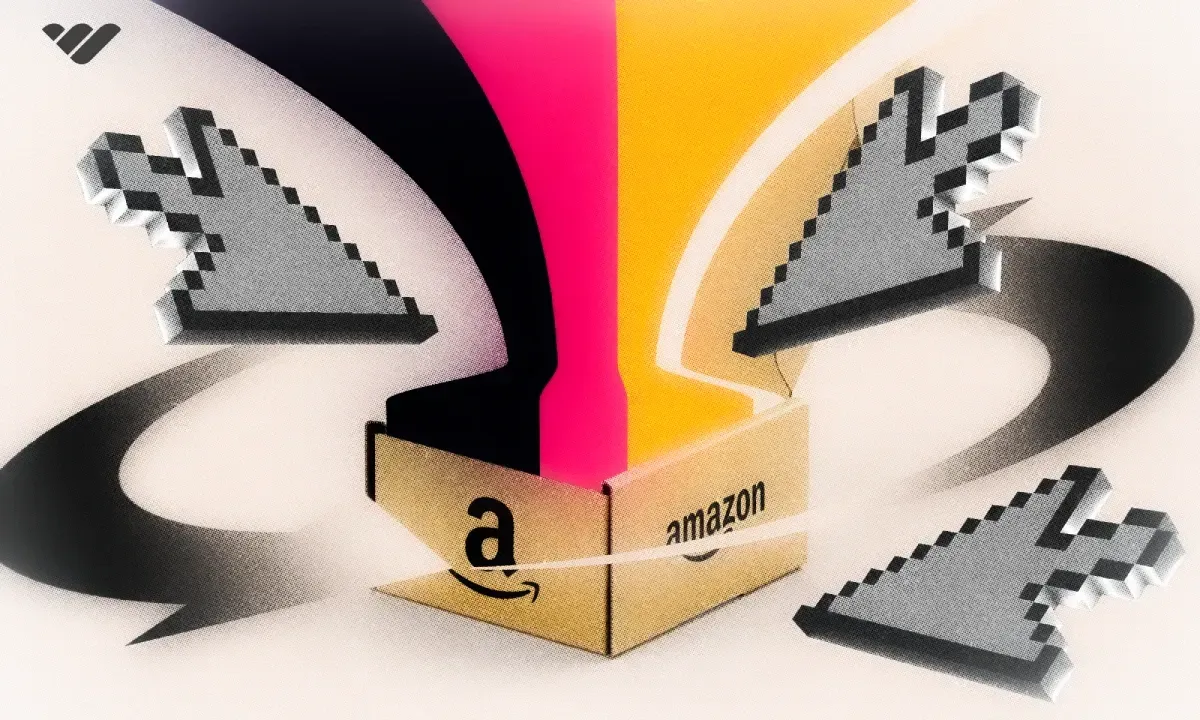
In order to understand what Amazon return pallets are, you must first understand Amazon’s return process.
The company touts superior customer service which includes an easy and notoriously lenient return process. This makes for a relatively high volume of returned products, with a return rate of up to 30% of sales in certain categories (such as clothing).
Amazon handles returned items in various ways depending on the seller’s preference, which sometimes includes redirection to liquidation via Amazon return pallets rather than restocking the item. Sometimes sellers will be forced to liquidate inventory if it is no longer in new condition. The seller is paid a percentage of the sales price and their inventory is then batched with returned inventory from other sellers.
These batches of returned inventory end up on liquidation marketplaces and are marketed as return pallets.
What Items Can You Get in an Amazon Return Pallet?
Amazon return pallets will typically include a wide assortment of individual items across various industries. For example, you might buy a return pallet and find clothing, electronics, kitchenware and beauty products inside. Whether or not you will know the exact contents inside will depend on the type of pallet you buy.
As a reseller looking to source inventory from Amazon return pallets, you’ll come across two main options, which are mystery pallets and manifest pallets.
Mystery pallets are generally cheaper, with a greater discount off of the retail price and a lower cost per item as a whole, however, when buying them, you won’t know the exact contents or the condition of the pallet until after you’ve received it. For the most part, you will accept the mystery pallets as-is, with no option to return any part or all of the inventory, which makes for a higher associated risk when buying them.
Manifest pallets, on the other hand, will show you the items in a detailed list, also known as a manifest. You will be able to see each item in addition to their quantity, condition, and sometimes even the suggested retail value. Because it takes these liquidation companies time to manifest contents for each pallet, you’ll have to pay a higher price, but this will come for a greater peace of mind and the ability to accurately forecast profits based on current market rates for each item inside.
If you are just starting out, you can most reliably make profits if you choose smaller manifested pallets that are within your niche. By doing this, you will already be familiar with performing accurate quality assurance on the product which will reduce risk and increase your ability to forecast profitability. Once you develop a broader knowledge across multiple niches and the best sales channels for each item, you can then move on to do larger manifest and mystery pallets.
How Much do Amazon Return Pallets Cost?
One key factor to deciding whether or not getting involved in Amazon return pallets is right for you is to forecast the cost.
The exact cost of an Amazon return pallet will vary significantly, but you should budget at least a few hundred dollars to get a pallet of decent quality. Return pallets can also cost upwards of $10,000, and generally, the more expensive they are, the cheaper the price per item will be compared to their retail value.
Price is based on several factors, including the type of items included, the condition they’re in, and whether the pallet is mystery or manifest.
Generally speaking, pallets with miscellaneous household products will be worth less than pallets with brand-name items and electronics that are in good working condition.
Once you’ve established a budget, you’ll be ready to buy a pallet, which starts by knowing some exact companies that openly sell them.
How Do You Buy an Amazon Return Pallet?
Buying an Amazon return pallet can be as simple as searching Google for the term, however, you’ll be met with several options of companies that have various reputation and practices.
Here are some of the most popular and reputable sources for buying an Amazon return pallet:
Amazon Liquidation Auctions
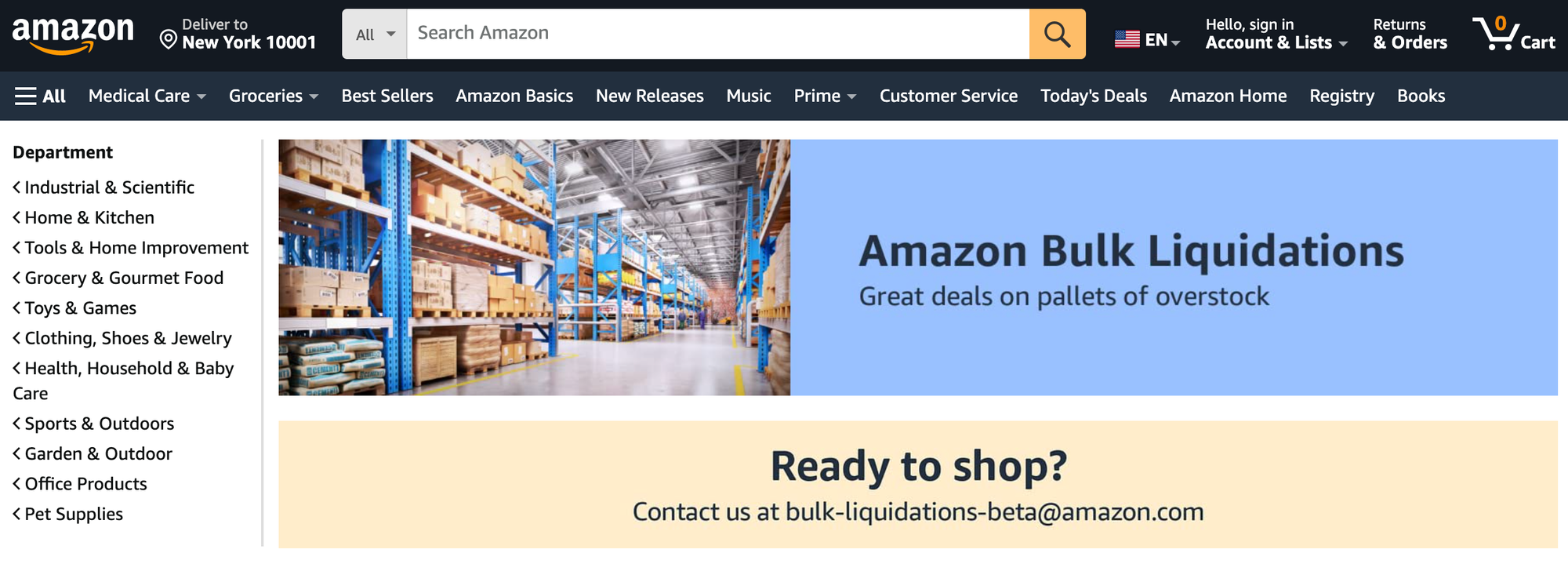
One of the best places to go for Amazon return pallets is directly to the source: the company’s very own Amazon Liquidation Auctions is an excellent resource for buying them.
The marketplace was established in 2018 through a collaboration with B-Stock, a company that partners with various big-box retailers to streamline the liquidation of customer returns. B-Stock is a direct affiliate of Amazon, so it often gets the earliest and best inventory.
In order to get pallets from Amazon Liquidation Auctions, you’ll first need to register your business with your local government and acquire a resale certificate. You’ll also want to register directly on B-Stock, which you can also use to browse an assortment of Amazon Liquidation Auctions.
Pros:
- Source for high-quality, manifested inventory
- Direct affiliate with Amazon means that the pallets are often newer and accurately described
- Access to shipping estimates, payment partners and other useful information
- Wide assortment of auctions that are clearly categorized
Cons:
- Competitive marketplace which attracts many buyers that you’ll be bidding against
- The auction format can be time-consuming and brings the responsibility of tracking bids all the way until the exact time of the auction close
Bulq
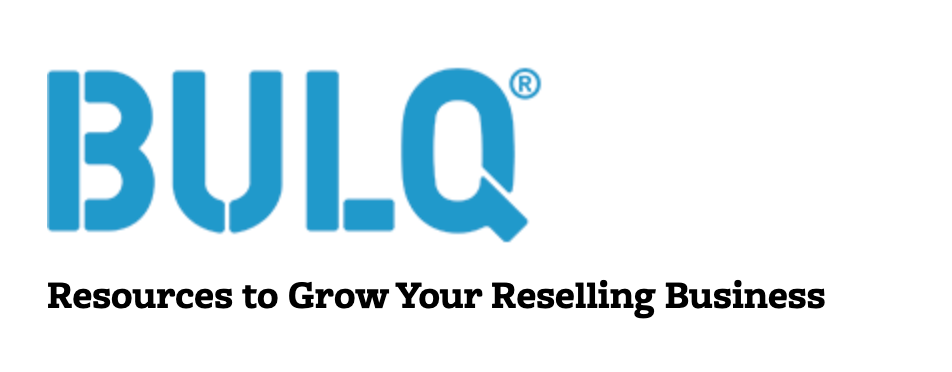
Bulq was established in 2004 as a liquidation company whose inventory sources include Amazon return pallets. The company has also partnered with eBay to provide a sourcing experience for eBay resellers who can use Bulq to seamlessly purchase and resell liquidation lots on eBay that come from both brand names and Amazon sellers.
It’s known for detailed manifests and high-quality, brand-name goods that are in demand, such as Apple and Samsung products in addition to name-brand clothing. Bulq also uses a fixed pricing model with flat rate shipping, which allows resellers to project profits better.
Pros:
- Brand name inventory with thorough photos and detailed manifests
- Easy to navigate and buy, with the option for immediate purchase in addition to auctions and flat-rate shipping
- Good availability and diversity of inventory
Cons:
- Relatively higher cost for manifested pallets
- Customer service can be difficult to deal with
- Item condition is sometimes not exactly as described, mostly with new products which may be an open box.
Quicklotz
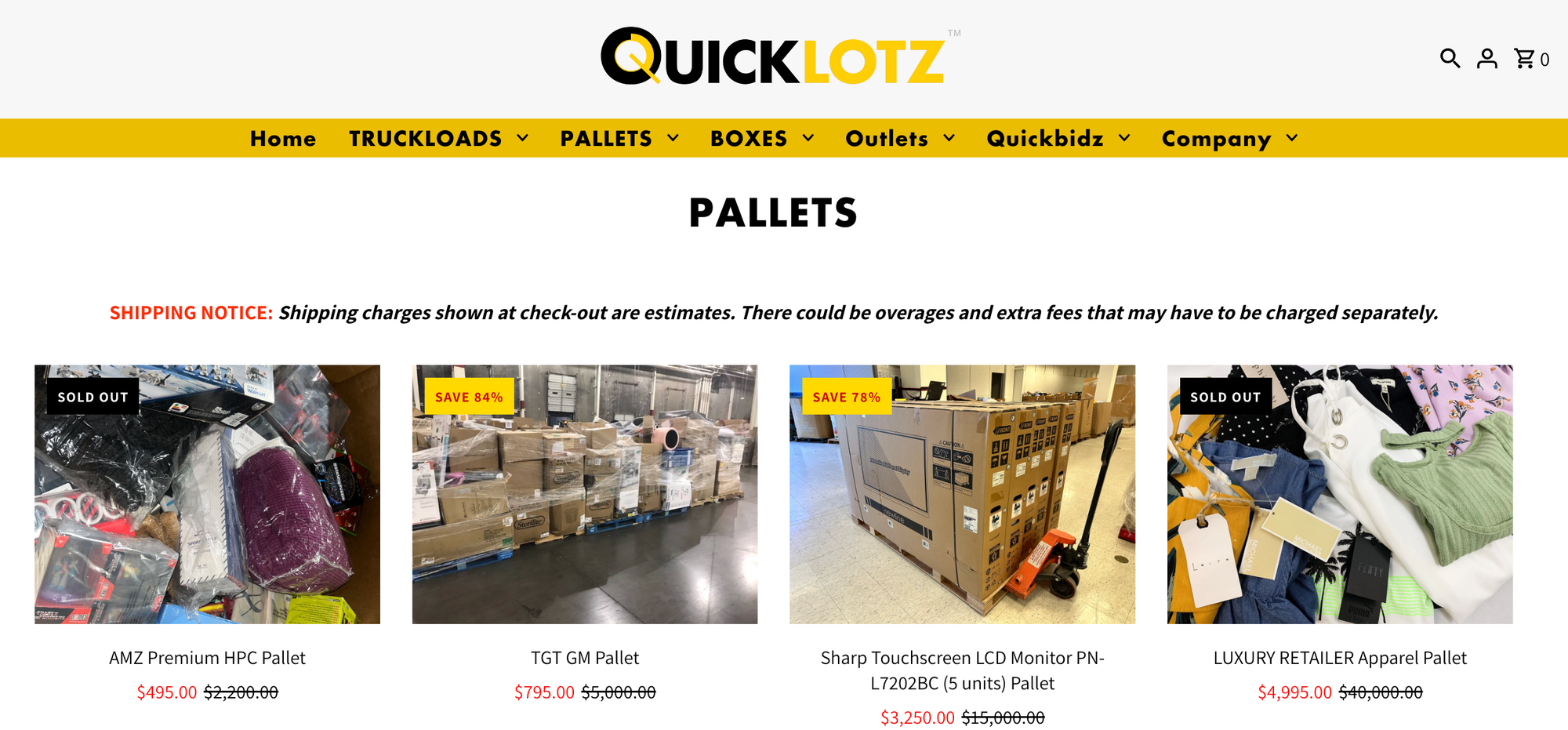
For those who are open to dealing with a wide assortment of inventory, Quicklotz is a great choice. The liquidation company is known for dealing with Amazon return pallets that are sold exactly as they were received, that is, unsorted and exactly in the condition as they were returned by Amazon customers.
Most of their inventory is sold in general categories, but there is also the option to buy mystery boxes from them. They offer inventory by the truckload in addition to pallet sales. Since the company does not need to take time and effort to list thorough manifests, the inventory is cheaper, but the uncertainty can mean receiving inventory that is unsellable or not profitable.
Pros:
- Lower overall pricing of inventory
- Several physical locations, which eliminates the cost of shipping and allows for thorough inspection
- Ability to buy in bulk by the truckload for even lower prices
Cons:
- Increased risk of acquiring damaged or lower-quality items
- No ability to accurately forecast profits before purchasing
- Organizing unsorted inventory is time-intensive
Liquidation.com
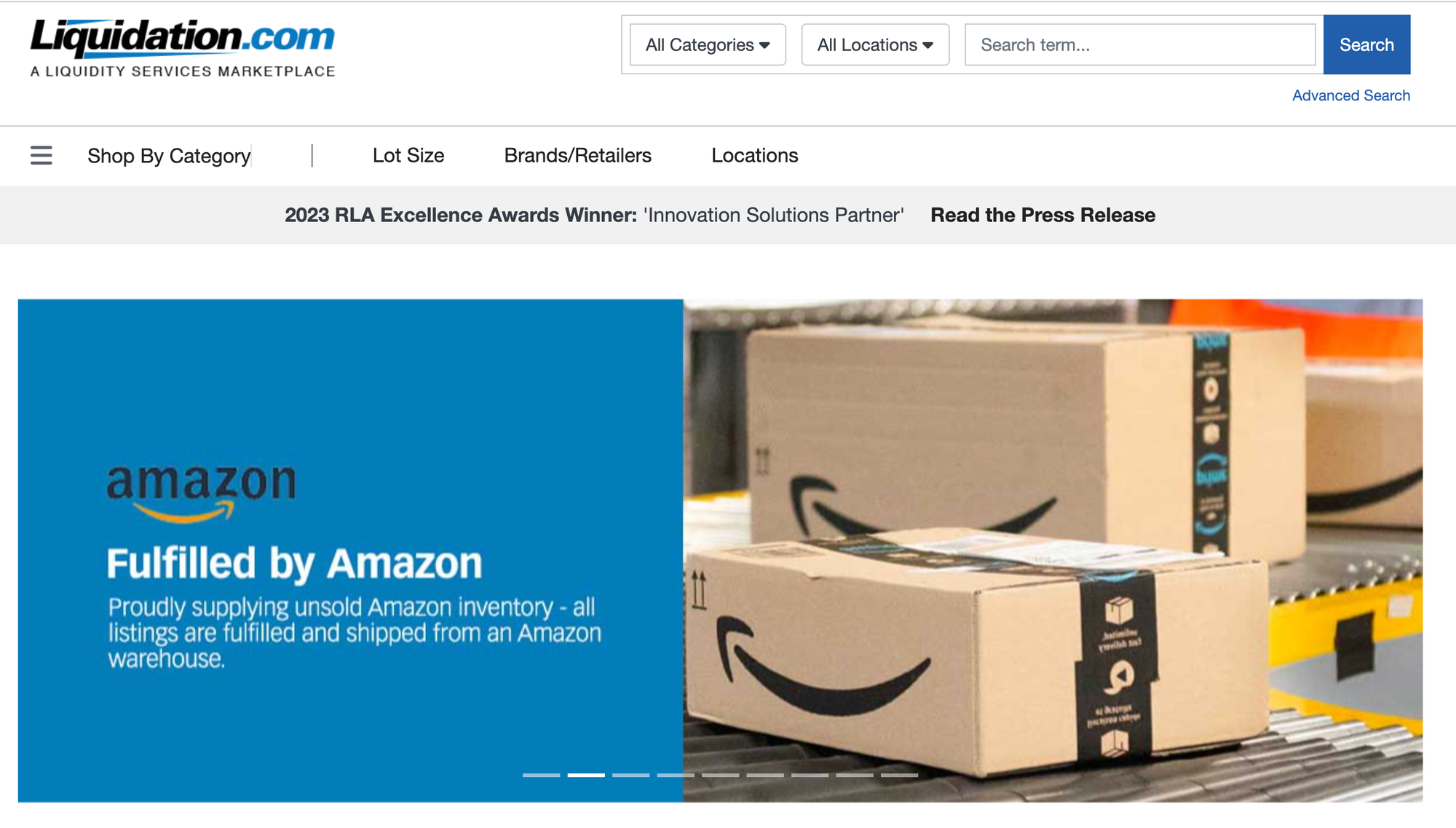
A liquidation wholesale provider for resellers that has been around since 1999, Liquidation.com has been around nearly as long as Amazon and remains as an established source for liquidated inventory, including Amazon return pallets.
The pallets are sorted by general category and sold in an auction format. You can also view statistics such as the location, overall views, amount of bidders and weight.
They have one of the largest and most diverse selections of wholesale inventory which comes from top retailers such as Target and Lowe’s in addition to Amazon.
Pros:
- Diverse inventory for any budget, with pricing as low as $100 for some clothing lots
- Large assortment of new items
- Manifests that include original retail pricing
Cons:
- Competitive auction format
- Variable shipping costs that are unclear
- Many listings have stock photos rather than actual photos
Via Trading

Via Trading has been operating for over 20 years as a top provider for wholesale inventory of liquidation pallets.
The platform provides access to Amazon return pallets across a vast assortment of categories, most notably brand-name clothing which they are known best for. Based in California, Via Trading has established a reputation of having great customer support, which includes catering to the Spanish-speaking market.
The company also has an active Instagram and blog which posts regular educational content in addition to updates regarding the latest inventory.
Pros:
- Known to have superior customer service, which is a rarity in the liquidation industry
- Ability to choose between auction and flat-priced purchasing of lots
- Great assortment of brand-name clothing and accessories
Cons:
- Variable lot quality, especially for those sold without manifests
- Limited selection of quality electronics
- Cluttered website that can be overwhelming to navigate
Wholesale Ninjas
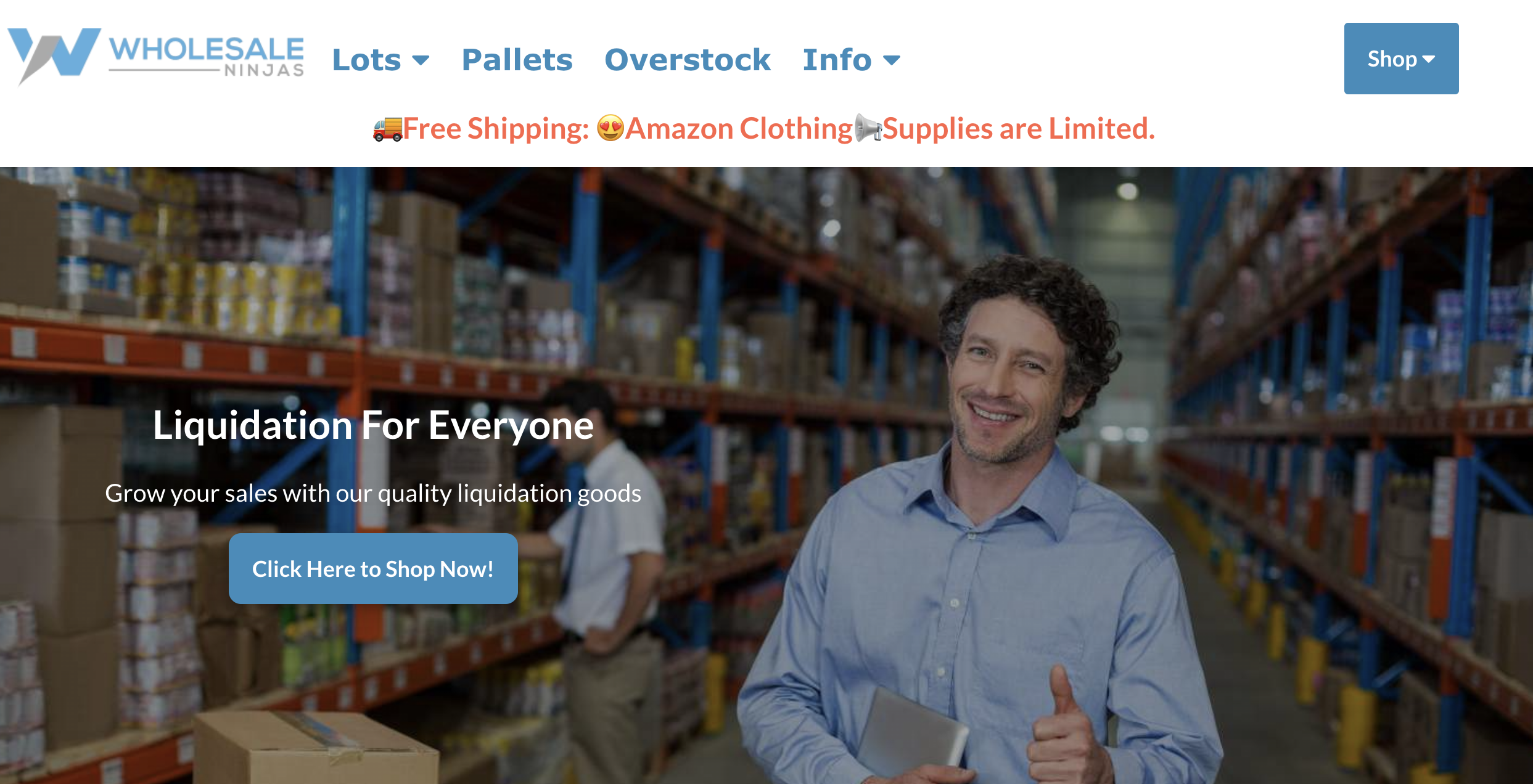
One of the newcomers to the wholesale liquidation game, Wholesale Ninjas was founded in 2018 and is focused on thoroughly sorting and accurately describing inventory.
They hold a high standard of product quality, and include a guarantee that 95% of products in any of their lots are in sellable condition.
The pricing of their lots can be quite affordable, with a large assortment of beauty and cosmetics items that can be purchased for around $100 or even less.
They offer fast and reliable shipping and eliminate the need for arranging for freight services with their pallet breakdown service that splits up the pallets and sends everything via ground shipping.
Pros:
- Easy buying experience with the ability to instantly purchase lots
- Regular sales for even deeper discounts
- Pallet breakdown service which eliminates the need for complicated freight shipping for larger purchases
Cons:
- Pricing is generally higher compared to other services which sell products as-is
- Many off-brand, unpopular products that lack a strong market demand
- All sales are final, so there is no accepting of returns or granting of refunds for any reasons
888 Lots

888 lots is a provider in the liquidation market which is best known for its pricing transparency and flexibility, which notably includes the ability to negotiate.
In addition to dealing with Amazon return pallets and returned inventory from other sources, they also offer a selection of brand-new items.
The company caters specifically to Amazon sellers, including FBA support, current item Amazon retail prices, and the ability to link an Amazon seller account to the platform.
They allow for the purchase of individual items at steep discounts, making it a great place for those who don’t have a large budget.
Pros:
- Ability to negotiate pricing for larger lots
- Can buy individual items
- Support for Amazon sellers
Cons:
- Variable inventory which makes it an inconsistent resource
- Lackluster customer service
- Risk of receiving damaged and expired goods
BlueLots
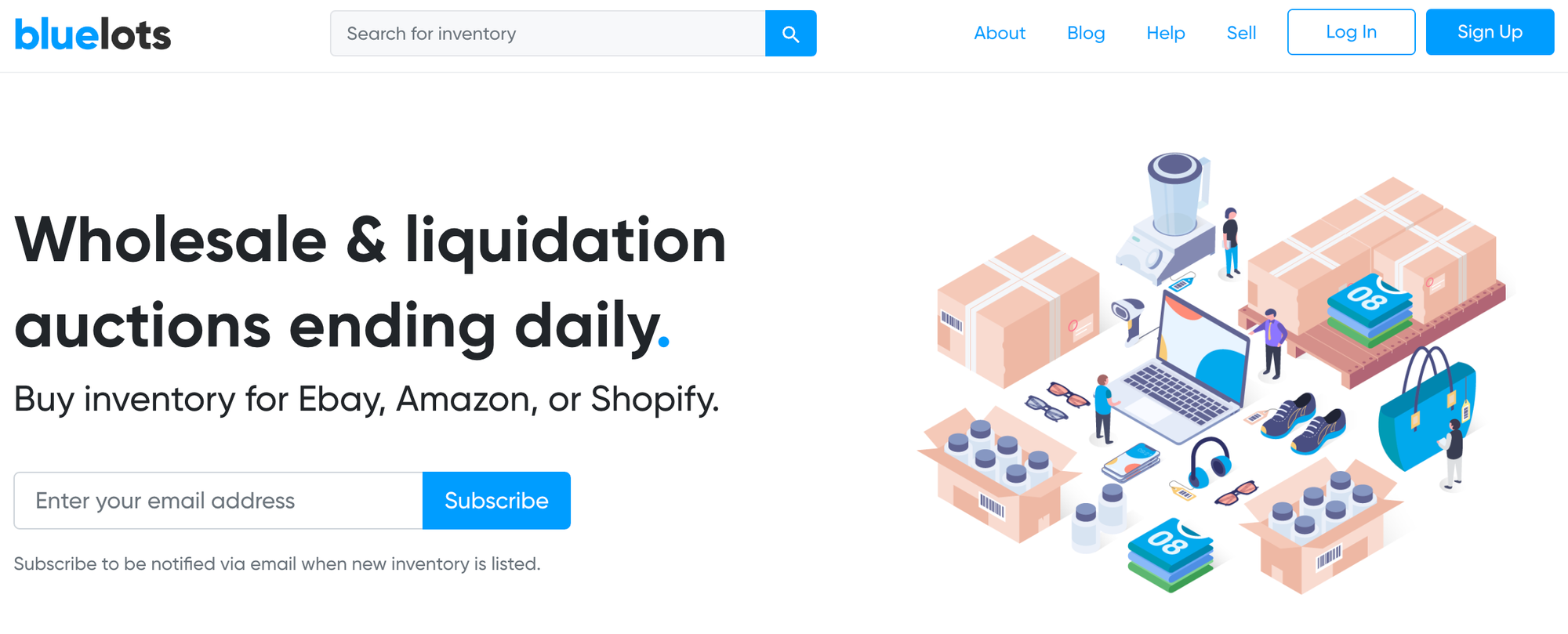
Founded in 2016, BlueLots is relatively new to the liquidation scene but has established itself as a reliable source for resellers looking to profit from Amazon return pallets and other wholesale inventory.
They are dedicated to serving businesses of any size, including individual entrepreneurs who are just getting started in the reselling game.
The pricing of their inventory includes immediate purchase in addition to live auctions, where you can quickly see the overall MSRP and the number of units.
Pros:
- Good listing format with detailed images and manifests, including a quick look at the overall MSRP and number of units
- Buy it now in addition to auction inventory
- Great for brand-new resellers at any budget level
Cons:
- Many of the items, especially the new inventory, are generic goods that have limited demand
- Complicated buying process which sometimes asks for ID verification
- Variable item condition which includes the risk of buying unsellable inventory
How to Buy the Right Return Pallet
Now that we’ve gone over the top marketplaces for sourcing wholesale inventory, including Amazon return pallets, you’ll want to keep a few things in mind, which include the following best practices:
Compare liquidation marketplaces
Be sure to research your options in terms of liquidation marketplaces, and choose one that aligns best with your goals and your niche. Each marketplace may differ in listing and purchasing formats, return policies, guarantees, and niche specialization.
Before becoming a customer, do as much research as you can by reviewing what current and past customers have to say about the business, including all of its pros and cons. You can research on YouTube, Reddit or reselling forums.
Start small
Even if you have a large budget to work with, it is smart to start as small as possible when buying your first pallet. Consider each pallet purchase as a test–as much due diligence you do on the marketplace and the exact pallet, you won’t know the quality of its contents until you make your purchase.
Sometimes, you might receive a pallet with items that are completely unsellable due to damage or lack of functionality. In this case, it’s likely that you will be stuck with the items as most liquidation companies sell everything as is with no returns accepted. Buying a small pallet with damaged goods from a company may mean that their larger pallets are also low quality, and by starting small, you’ll be avoiding a more costly mistake.
Factor in shipping costs
When it comes to buying pallets, shipping costs may add increased expense as buying in bulk comes with costly shipping, and may mean that you’re dealing with freight shipping, which is more expensive and can require more complex logistics than shipping a normal package.
Some platforms offer flat shipping for different pallet size categories, while many will offer variable rates that might require manual calculations based on how far you are from the inventory to figure out how much you’ll pay. If a company has a physical location within driving distance from you, it may be worth heading over there to pick it up in person as this will eliminate shipping costs altogether.
Be selective in your pallet type
Liquidation companies process return pallets differently, with some pallets sold unsorted, un-inspected and exactly as they were received, with others sorted, broken down and thoroughly manifested.
The more effort and resources a company must use to prep a pallet for sale, the pricier the pallet will be. This will cut into your overall profit margins, but it will drastically lower your risk as you will more accurately be able to project whether or not you’ll be able to turn a profit by selling each item individually.
10 Steps to Buying and Selling Amazon Return Pallets
In addition to knowing where and how to acquire them profitably, buying an Amazon return pallet requires a strategic execution of exact steps. The following is an example of how you can carry out this process step by step:
1- Conduct Thorough Market Research
As a reseller, you’ll be competing against many others who are selling the exact same product, so in order to get an edge and establish expertise, you’ll want to first conduct thorough market research. This is particularly the case when it comes to buying and selling Amazon pallets because your investment is higher than dealing with individual items.
You’ll want to figure out which current market trends you can capitalize on and how quickly and at what profit margins you can sell a certain product. Take advantage of tools and software such as Helium10 and JungleScout that can show exact Amazon sales stats in addition to some manual research on eBay and shopping results on Google. Make notes of price discrepancies and sales volume within different marketplaces compared to the cost per item when acquiring via a pallet.
2- Properly set up your business to register with a liquidation company
Liquidation companies are B2B marketplaces, so in order to deal with them, you’ll have to be legally and properly registered as a business. You can begin by setting up an LLC or a similar structure and then using that to apply for and acquire a resale permit while following the exact laws of your local jurisdiction throughout the process.
By setting yourself up properly in the beginning, you’ll be able to register as a customer for all liquidation companies as many will only do business with registered reselling companies.
3- Secure adequate storage space
Dealing in bulk inventory demands storage space, and before you know it, the storage you need can go far beyond a garage or any spare room you may have in your residence.
In addition to thinking about the size of the storage space, you need to make sure it’s well organized and easy to deal with in terms of logistics. As you scale, you can use a 3PL which can warehouse your inventory and fulfill orders as they come.
Other factors you need to consider when thinking about storage space are climate and security if you’re dealing with sensitive items.
4- Analyze the available pallets
Finding the best pallet can be like panning for gold amongst rocks, so it will take patience and thorough analysis of all available pallets to find the best one.
You can save time by not dealing with certain liquidation marketplaces altogether that may not have the best reputation, or those that don’t include thorough pictures or detailed manifests.
Make a list of the best pallets and then run calculations based on your expected profit margins on each of your reselling channels. While this process will be time-consuming at first, it’s a necessary base for good business practice as a pallet buyer and it will get faster as you gain more experience.
5- Make a strategic pallet purchase
After you’ve compiled your list and run calculations, you’ll be ready to make your purchase. If you’re dealing with auctions, be sure to make time to prioritize a free schedule surrounding the end time of the auction as bids can come at the very last second, especially for hot lots. Create and stick to a maximum bid price that you won’t surpass so you can remain profitable.
For pallets that are listed in a buy-it-now format, make the purchase right away if it’s within your expected profit margin, which in pallets should be between 30-50% or more. If the platform allows negotiation, consider contacting the supplier for a lower price, but remember that you’re competing with other buyers who might pay more than your offer, so be reasonable.
6- Set up shipping and logistics
Having an efficient system for logistics on both the buying and selling side is crucial for running a profitable business that deals with Amazon pallets. When making your initial purchases, make note of how much the shipping cost was for each supplier as the rates can vary widely. If you’re able to pick up inventory physically, be sure to arrange that you can have proper transportation storage and pick up as much inventory as you can at once.
In terms of fulfillment, you’ll want to make sure that you choose a shipping provider that is reliable and cost-effective. As you increase in volume, you can negotiate shipping rates or potentially outsource part or all of the fulfillment process.
7- Sort and process your inventory
Pallets are notorious for being disorganized and cluttered, and this is especially true if you’re dealing with mystery pallets. Even if you’ve purchased a manifested pallet, you’ll want to double-check the accuracy of the manifest in terms of quantity and condition. If there are any discrepancies, see if you can contact the customer service of a company and get any form of resolution, but be aware that some companies will stick to an inflexible sold-as-is policy.
Sort your items so that they’ll be easy to pick and pack later on, and if you can, improve the condition of the items by refurbishing or cleaning so you can sell for an even higher price. Be sure to accurately advertise the condition of the item so you can maintain a high seller reputation on every sales channel that you utilize.
8- Utilize multiple channels to sell and fulfill your products
Diversification is the key to any successful investment, including reselling Amazon return pallets. Initially, your sales channels might be somewhat limited, but you can still utilize eBay and Facebook Marketplace to sell pretty much anything as a brand-new seller. As you gain reputation and business history, you can be approved to list on more premium and active marketplaces such as Amazon, which has the added perk of its FBA program which takes care of all aspects of storage and fulfillment.
Be sure to compare the going rate of your items on each sales channel, and factor in the cost of shipping and any other platform fees. Consider selling a portion of your inventory in person using Craigslist, Facebook Marketplace or any other local listing platform, as some items might only be profitable if they are sold without shipping or platform fee costs.
9- Manage your inventory and customer service
In order to run a proper business reselling Amazon return pallets, you’ll need to be effective at both managing your inventory and providing good customer service. Using spreadsheets to stay organized and accounting software like Quickbooks will make your life easy come the inevitable tax season and it’ll also help you stay on track with your goals and to record and project profitability.
Your reputation as a seller will allow you to attract and maintain a loyal customer base, which is one of the biggest components of running a long-term and sustainably scalable business. Be sure to address any inquiries and potential concerns quickly and truthfully, and do as much as you can to be clear in your listings and your policies which will greatly reduce any unnecessary and inefficient communication with customers.
10- Create SOPs to rinse, repeat, and scale
Dealing with Amazon return pallets is complex and requires arranging different moving parts, and while this is time-consuming at first, you can speed up the process using SOPs, or standard operating procedures.
An example of an SOP is a step-by-step process for exactly where to source pallets and how to split up, process and sell them, including qualifications that act as a boundary for determining when and how to purchase and fulfill a product depending on its category.
By creating SOPs, you’ll not only make your own workflow more efficient, you’ll be able to delegate to a team so that you can have more time and focus on performing high-leverage tasks. This will allow you to scale as you gain profitability and gain more bandwidth to expand your operations. Top resellers that operate in the seven-figure realms all operate with significant volume, and this is only possible with proper and effective SOPs that a team can easily follow.
Is Buying Amazon Return Pallets Worth It?
As a reseller, Amazon return pallets are a great choice for incorporating a strategy that is sometimes overlooked and can allow you to get a price per unit that can only be had otherwise if buying in large bulk amounts.
Once you’ve done your due diligence, forecasted profitability, and set up systems to organize and scale your business, you have the potential to build a thriving reselling business that can be built entirely off of Amazon return pallets.
However, dealing with Amazon return pallets includes inherent risks, which you’ll need to keep in mind in addition to the positives. Here is a summary of the positive aspects in addition to the potential risk involved with each benefit:
| Benefit: | Potential risk: |
|---|---|
| New channel for sourcing inventory to resell | Requires proper business set up and registration |
| Reduced price per item which increases potential profit margin | Risk of receiving items that are not fit to be resold, cutting into the overall margin of your purchased batch |
| High degree of inventory variety available in a single purchase | Can include items with low market demand |
| Broad exposure to multiple categories | Time intensive research and constant learning |
| Bulk purchases allow profitable acquiring of large amounts of inventory | Requires substantial storage space, sorting and logistics |
| Diverse buying formats, including auctions | Auctions can be competitive and require time and tracking to win |
Successful resellers who incorporate Amazon return pallets in their business model will have all of these benefits and potential risks in mind, and will start small so that the initial mistakes are less consequential. As they establish business history and consistent profitability, they can slowly scale with SOPs. By adhering to a well-defined and thought out plan and executing consistently, they can maximize benefits while minimizing the downside.
Find Reselling Success With Whop
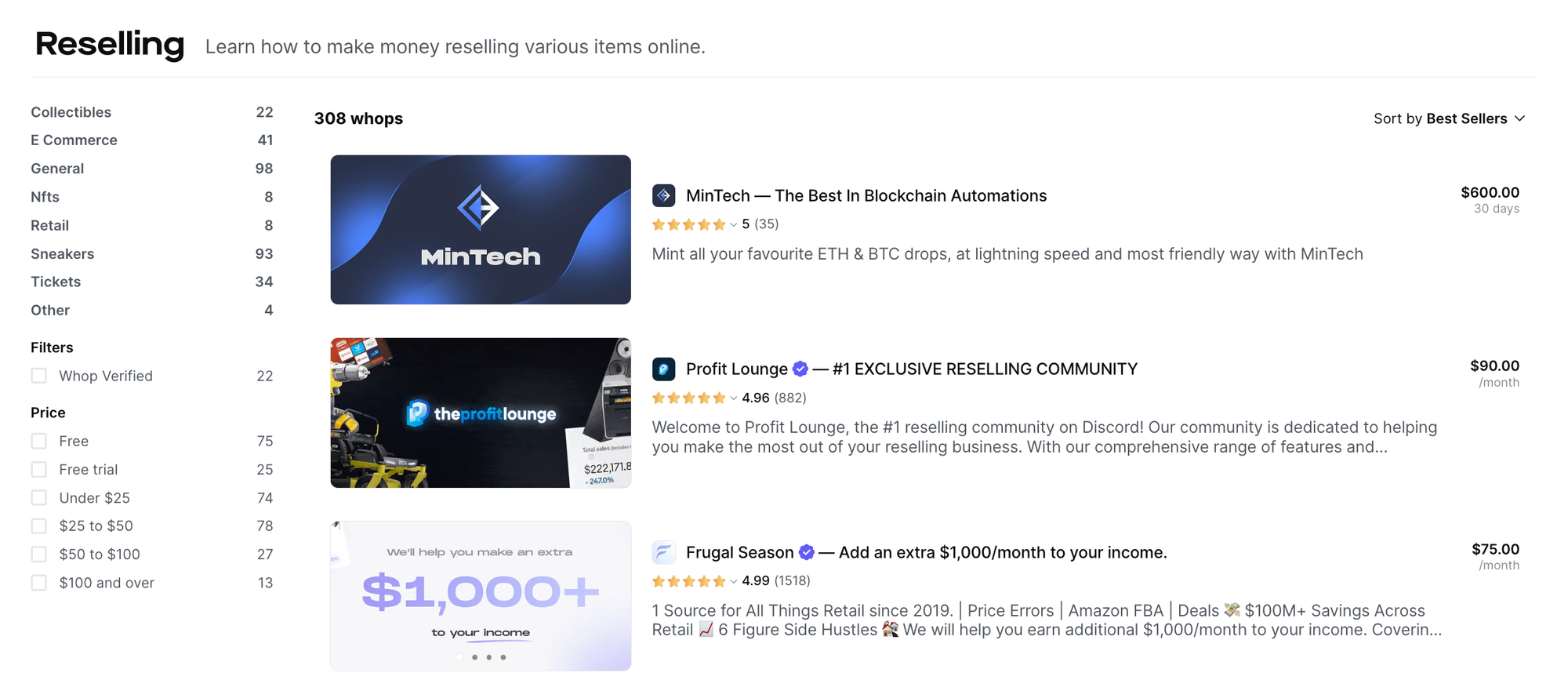
While buying low and selling high–the definition of reselling–is simple in theory, it can get nuanced and complicated fast as you’ve seen in the case of Amazon return pallets. Although the steps for engaging in this business have been laid out in this guide, carrying them out will take time and motivation to follow through, and you might also run into a specific issue or have a question that doesn’t have a readily visible solution anywhere online.
Getting real-time, immersive education will not only save you potentially costly beginner mistakes, but it will also greatly shortcut your time to profitability inside of an active, expert-led environment.
If you’ve been interested in reselling or have been dabbling in it but haven’t yet found the success you’ve been wanting, joining a reselling group on Whop might be what gets you there.
Check out all of the best groups for reselling right here, which include advice on how to profit like a pro in a diverse set of categories while using multiple sales channels.
Amazon Pallet FAQs
What is the best way to sell Amazon return pallets?
Generally speaking, the best way to sell Amazon return pallets is to split them up and sell each individual item in the marketplace where it is most profitable. However, in order to do this, you’ll need to spend time researching each pallet to project your expected return and to determine whether or not a pallet is worth buying.
Are Amazon return pallets always profitable?
While all pallets will be sold at a steep discount below the cumulative MSRP of all of the items in its contents, this will not translate to guaranteed profitability. This is because Amazon return pallets include items in variable condition, which includes the chance of ending up with items that are unsellable..
Can I choose the items I get in an Amazon return pallet?
Unlike traditional buying of inventory in bulk, you cannot pick and choose the type and quantity of the items that make up the contents of your Amazon return pallet. However, if you’re dealing with manifest pallets, you’ll be able to see exactly what items are included and their expected condition. With some liquidation platforms, you’ll be able to sort pallets by category so you can at least choose the niche you’re dealing with.
What can I do if I receive damaged goods or unsellable items in a return pallet?
For the most part, you will have to accept your entire purchase as is, without the potential to return or receive compensation for any part of your pallet. This is due to the nature of liquidation businesses which rely on volume and operate on slim profit margins. In order to avoid receiving damaged goods or unsellable items in a return pallet, you should do as much due diligence on the company and the specific pallet that you intend to purchase before buying it. In some instances, companies might be able to assist if there is a huge discrepancy in what you bought versus what you received.



![Top 18 best ticket reselling Discord servers [November 2024]](/blog/content/images/size/w600/2023/12/Top-Ticket-Reselling-Discord-Servers--1-.webp)
![Top 22 best sneaker reselling Discord servers [2024]](/blog/content/images/size/w600/2024/01/sneaker-reselling-discord.webp)
![Top 26 best reselling Discord servers [November 2024]](/blog/content/images/size/w600/2023/09/reselling-discords.webp)